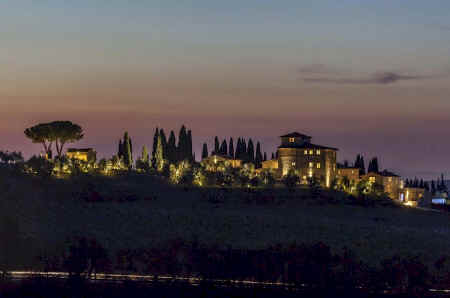|
There are three locations in Italy that bear the name
Vitigliano, two in Tuscany and one in Apulia:
-
The borgo of Vitigliano located on the old road between
Panzano and
Greve in
Chianti. A "borgo" is a small inhabited
nucleus, more or less a hamlet, often grouped around an ancient
structure such as a castle or watch tower. The borgo of Vitigliano
was probably a Roman foundation and in its present form developed
around a watch tower that was an outlier of the castle of Panzano.
The borgo of Vitigliano was once part of the holdings of the
Verrazzano family and it has recently been tastefully restored as a
luxury private hotel and spa under the name Vitigliano
Relais and Spa. The old road on which Vitigliano is located
was part of the principal road from Florence to the confines of
Siennese territory. By the 18th century, this route had become known
as the Via
Chiantigiana. The new section of road that bypasses the old
road adjacent to Vitigliano was created during the mid-19th century.

Learn more about Vitigliano
luxury accommodation and retreat in Tuscany.
-
Villa Vitigliano located above the borgo di
Vitigliano in the direction of Panzano. Although a property at this location is mentioned in a
document dated 1427, the current principal structure is a huge 18th
century villa, surrounded by farm buildings which are mostly 19th
century. The villa also belonged to a branch of the Verazzano family
until as recently as 1936. It is currently unoccupied. The borgo and
the villa of Vitigliano near Panzano were identified as separate
entities from at least 1427 when we see the area of the villa
designated Vitigliano di Sopra, while Vitigliano di sotto,
the borgo and current Vitigliano Relais and Spa, is first documented
as such in 1498.
-
Another Tuscan Vitigliano is located in the Mugello near Florence.
The Historiae urbium et regionum Italiae rariores of 1748,
describes the parish church of S. Alessandro a Vitigliano,
and Repetti, in his comprehensive Dizionario Geografico Fisico della Toscana
of 1833 - 1846 describes more fully Vitigliano del Mugello nella Valle della Sieve
as a castle together with the church of S. Alessandro and the ruins
of a tower named Montacuto, located in the comune of Vicchio, the birthplace of
Giotto and
Beato Angelico and which is around 4 km away. The original 12
C castle belonged to the Adimari family but was destroyed in
the 13 C during the war between the
Guelfs and
Ghibellines.
The remaining structures at this site belonged to the Church until
1350 when the property fell into the hands of Counts Guidi and were confirmed to them by Henry VI and Frederick II.
The Guidi family seem to have ceded these properties to the Badia di
Firenze in 1485. The 13th century church has been incorporated into
a villa and there is another 19th
century villa nearby, now known as Villa Vitigliano.
-
There is a village named Vitigliano,
with interesting megalithic archaeological sites nearby, located in Apulia near Lecce, right on the "heel"
of the Italian peninsula. The village of Vitigliano is administered
by the municipality of Santa Cesaria Terme.
There are at least two possible the
meanings or origins for the name "Vitigliano":
-
The most likely origin of the name Vitigliano, especially in Tuscany,
the land of grapes and wine, is
from the latin word vitiarum, meaning a vineyard, and
indicating cultivation of grapes in the area.
-
Although Vitigliano and Vitagliano are possibly not
related words, nevertheless, mediaeval spelling being what it was,
we do see, in a document dated 14 November 1085, the Vitigliano
property at Panzano referred to as Vitagliano. All later documents,
dating from the 14th century onwards, use the spelling Vitigliano.
As indicated below, the name Vitagliano is more likely to be derived
from a Roman personal name such as Vitalis, Vitellius or Vetilius,
and any of these could have been the name of the Roman owner of a
property that took its name from that of that owner. The territory
from Florence as far as Panzano is known to have been intensively
cultivated during Roman times.
-
Local historians of the town of Vitigliano near Lecce favour
derivation of the name of their town from a Roman personal name,
namely of a Roman centurion called Vitelius (or Vitellius), who,
upon retirement, was rewarded with this land for his courage on the
battlefield. He built his own house and that of his soldiers, and
from these beginnings grew the village of Vitigliano.
-
A folk story popular in the area of the town of
Vitigliano tells of a calf (vitello) that escaped from the
herd and was pursued by two cowherds who in this way discovered the
location that is now Vitigliano. The coat of arms of this Vitigliano
features a star at the top and below an olive tree with a calf next
to it.
The name "Vitagliano" is in fairly common use as a personal name in southern Italy,
especially in Campania and Calabria. Vitagliano is a dialectical variant of
Vitaliano which in turn is derived from the Latin personal and family name
Vitalianus, itself a derivative of vitalis, the Latin
word meaning "of life, vital (in the sense of 'living')". Vitalis
was also used as a personal name in Roman times and is the direct origin
of the common Italian family names Vitale and Vidal and
their multitudinous Anglo-Norman, French, Spanish and other
variants. Vitellius and Vetilius are Roman personal
names with derivations different from that of Vitalis.
|
